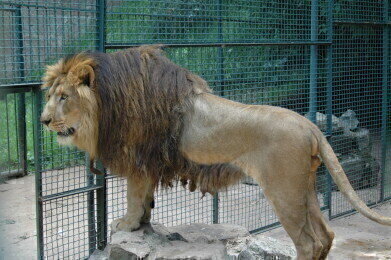-

-
 Michael Hofreiter
Michael Hofreiter
News
DNA Confirms Distinct Ethiopian Lion
Oct 21 2012
International researchers from the University of York and the Max Planck Institute for Evolutionary Anthropology, have provided the first comprehensive DNA evidence that the Addis Ababa lion in Ethiopia is genetically unique and is urging immediate conservation action.
With a distinctive large, dark mane, this smaller and more compact breed are declining in numbers; in addition to a few hundred wild lions scattered throughout the country, 20 lions are kept in the Addis Ababa Zoo, originating from a collection established in 1948 by the late emperor of Ethiopia, Haile Selassie. The seven founder lions (five males and two females) are claimed to have been captured in south-western Ethiopia, although their geographical origin is controversial.
The researchers compared DNA samples from 15 Addis Ababa Zoo lions (eight males and seven females) to comparative data of wild breeds in Africa and Asia.lion breeds in the wild. The results of the study, which also involved researchers from Leipzig Zoo and the Universities of Durham and Oxford, are published in the European Journal of Wildlife Research.
Principal Investigator Professor Michi Hofreiter, of the Department of Biology at the University of York, said: “To our knowledge, the males at Addis Ababa Zoo are the last existing lions to possess this distinctive mane. Both microsatellite and mitochondrial DNA data suggest the zoo lions are genetically distinct from all existing lion populations for which comparative data exist.
We therefore believe the Addis Ababa lions should be treated as a distinct conservation management unit and are urging immediate conservation actions, including a captive breeding programme, to preserve this unique lion population.”
The lion (Panthera leo) is the principal terrestrial predator in Africa and therefore a key species of the savannah ecosystem. Numbers, however, are in serious decline and two significant populations – the North African Barbary lions and the South African Cape lions have already become extinct in the wild.
Professor Hofreiter said: “A key question is which wild population did the zoo lions originate from and whether this wild population still exists; this would obviously make it a priority for conservation. What is clear is that these lions did not originate in the zoo, but come from somewhere in the wild - but not from any of the populations for which comparative data is available.
Digital Edition
Lab Asia Dec 2025
December 2025
Chromatography Articles- Cutting-edge sample preparation tools help laboratories to stay ahead of the curveMass Spectrometry & Spectroscopy Articles- Unlocking the complexity of metabolomics: Pushi...
View all digital editions
Events
Jan 21 2026 Tokyo, Japan
Jan 28 2026 Tokyo, Japan
Jan 29 2026 New Delhi, India
Feb 07 2026 Boston, MA, USA
Asia Pharma Expo/Asia Lab Expo
Feb 12 2026 Dhaka, Bangladesh


















